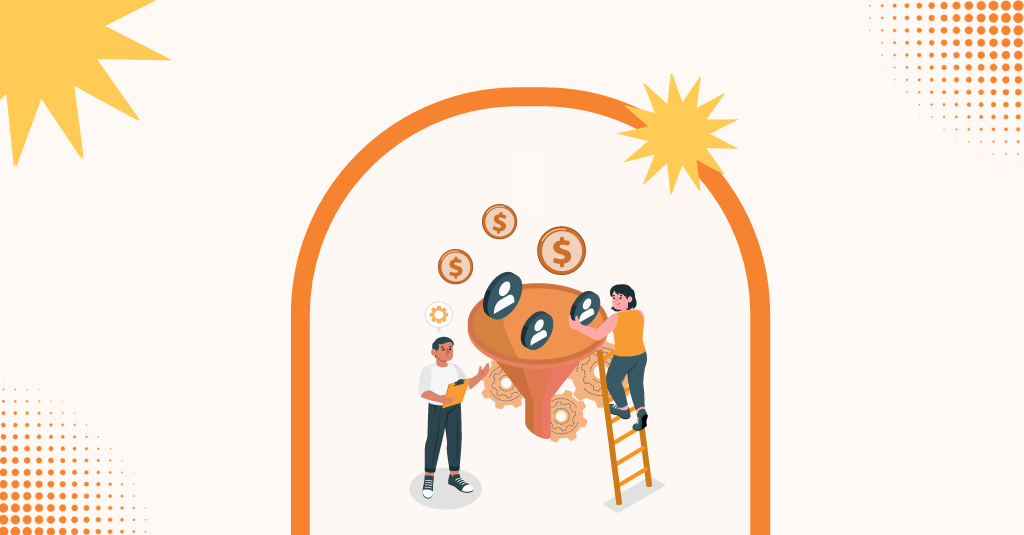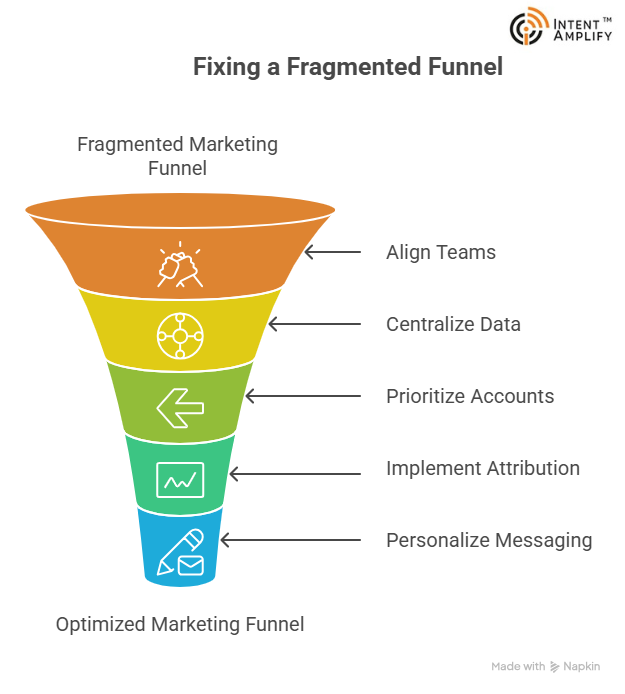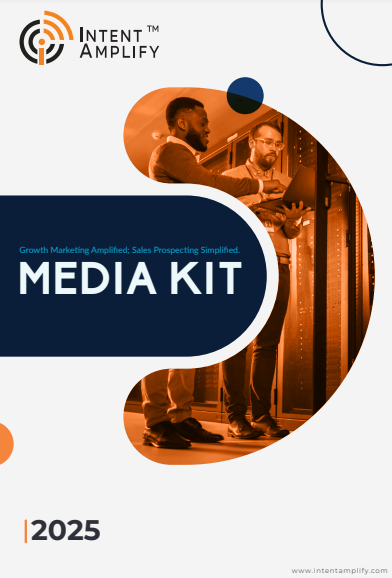
Fixing Fragmented Marketing Funnels: Why B2B Conversions Are Stalling in 2025
- Last updated on: July 28, 2025
Fragmented marketing funnels are quietly but quickly killing B2B conversions in 2025.
The majority of marketers don’t notice it’s happening until the results begin to slip.
Leads disappear halfway along. Sales accuses marketing. Attribution gets messy. Pipeline velocity dwindles despite increased spend, more tools, and more campaigns.
The problem isn’t volume, though. It’s a connection.
Throughout today’s funnel, data is fragmented. Teams have disparate objectives. Touchpoints aren’t coordinated. One buyer may receive five disparate communications from three separate teams.
That’s fragmentation.
It’s no longer simply inefficient; it’s a revenue inhibitor. Today’s B2B buyer demands a smooth, relevant experience from awareness through closed-won. When your funnel can’t provide that, they turn off quickly.
To get a sense of how we reached this point, we must examine how B2B funnels have developed.
What used to work cohesively has become more layered, technology-oriented, and burdened. The fragmentation we experience today didn’t occur overnight, rather, it was the consequence of explosive growth, increasing complexity, and a market that advanced faster than its systems allowed.
From Growth to Saturation: How B2B Funnels Broke Down Over Time
The B2B marketing funnel was not complicated.
In the early 2010s, it existed on a mostly linear journey, from awareness to interest to action, typically driven by sales with backing from marketing.
The teams were tiny. Tools were less numerous. Campaigns were simpler to manage. As digital channels proliferated and buyer behavior changed, marketers turned to automation, content strategy, and personalization to get more engagement at scale. The solution worked, initially. But innovation became saturated.
In attempting to do more at more touchpoints, teams quietly lost sight of the complete journey. What once was a single pipeline evolved into overlapping workflows and broken buyer experiences. Fragmentation wasn’t sudden. It snuck in slowly, driven by growth outpacing integration.
Here’s what happened:
- More channels, more mess:
Email, search, social, video, and partner campaigns opened up multiple entry points, a few of them integrated.
- Marketing automation amplified with no synchronization:
Sequences and nurtures became networked but frequently disconnected from the sales context.
- Content overwhelmed the journey:
With dozens of assets per persona, consistency of messaging grew more difficult to control.
- Every team created its own stack:
Demand gen, product marketing, sales enablement, and ops often operated on discrete platforms.
- Buyer signals were lost in the fray:
Intent, engagement, and lead scoring data are seldom communicated cleanly across teams.
Buyers started to notice the gaps first, through uneven messaging, redundant follow-ups, and irrelevant handoffs. And while teams doubled down on more content and more investment, conversion rates started lagging rather than accelerating.
In 2025, fragmented funnels are the norm, not the exception. The new B2B journey remains full of promise, but when there is no alignment, it leaks at every point.
Why Fragmentation Is Hurting B2B Conversions in 2025
Modern B2B buyers interact with an average of 10+ channels during their decision-making process.
This shift is no longer trivial; it’s fundamental. McKinsey’s latest B2B Pulse Survey (2024/2025) reveals that over half of decision-makers would abandon a potential purchase due to a poor-quality omni-channel experience, regardless of lead volume.
Fragmentation doesn’t only cause operational inefficiencies, it hits the bottom line.
In modern B2B buying, where every buyer interaction counts, even slight breaks in the funnel can stall deals or send them crashing off course.
Buyers want relevant information. A message that your company gets them and where they are on the journey. But when messaging, data, and ownership are fragmented, that message is lost, and so is the conversion.
According to Forrester research, 82% of B2B marketing decision-makers believe buyers expect personalization across marketing and sales.
This disconnect results in:
- MQLs are getting stuck at the handoff point, and marketing sends leads that sales considers unqualified.
- Inconsistent messages between channels, buyers see product-oriented ads while still investigating the issue.
- Engagement fall-offs, nurturing programs don’t show what the buyer has already consumed on blogs, videos, or downloads.
- Longer pipeline duration, context is forgotten between touchpoints, and must be relearned by sales teams.
What does this translate to in 2025?
That separated funnels aren’t just wasteful, they’re costly. Each misstep keeps multiplying:
- Lower conversion rates.
- Higher CAC (Customer Acquisition Costs).
- Longer sales cycles.
- Poor buyer experience and brand trust erosion.
And the issue isn’t a shortage of tools. It’s a shortage of connected strategies. A majority of funnels have the right strategies, but alone.
If organizations wish to achieve higher conversions, they require more than mere leads. They require cohesion.
The change from linear to layered funnels wasn’t an error; it was due to buyer expectations and market complexity. But in the pursuit of scale, many teams lost something invaluable: alignment. What once fueled momentum now causes drag. The more disrupted the funnel is, the more difficult it is to progress buyers.
That resistance is now manifesting where it hurts the most; conversion rates.
Fragmentation isn’t always visible from within. Teams remain busy. Content is shipped. The budget is spent. But when the funnel cracks between touchpoints, performance grinds to a halt quietly, until it’s too late.
Repairing it isn’t about rebuilding everything. It’s about joining the right pieces of data, messaging, and ownership throughout the buyer journey.
Here’s how to do that in 2025.
How to Fix a Fragmented Funnel: 5 Proven B2B Tactics That Drive Alignment
You don’t require additional tools; you require better connections between the ones you have. These five strategies unify your funnel, accelerate conversion momentum, and minimize wasted effort across teams.
1. Align GTM Teams Around Shared Funnel KPIs
Too many teams, too many dashboards, not enough shared objectives.
Begin by establishing clear, end-to-end KPIs that marketing, sales, and revenue teams all agree on, such as pipeline velocity, SQL-to-win ratio, or lead engagement duration.
- Replace siloed metrics (MQLs vs. SQLs) with common pipeline health metrics
- Perform regular funnel syncs between marketing and sales
- Create mutual accountability in campaign reviews
The key here is to maintain the funnel as a single system, not a marketing phase and then a sales phase.
2. Centralize Buyer Data and Insights
Data isn’t the issue. Disconnected data is.
Use a single data platform or solid integrations to have buyer behavior, intent, and engagement signals move between systems in real time.
- Unify CRM, MAP, and behavioral data into one buyer view
- Trigger contextual follow-ups and handoffs with data
- Empower SDRs and AEs with real-time visibility into what buyers are interacting with
Too many tools are confusing. Unified intelligence fosters trust.
3. Turn Intent Data On to Prioritize High-Fit Accounts
Not all leads are equal. Intent data can reveal which accounts are actively researching your solutions, so your teams concentrate where demand already prevails..
- Track real-time buying signals across topics, keywords, and competitor activity.
- Route the high-intent accounts into targeted nurture paths.
- Notify sales teams when leads peak in intent.
Don’t guess who’s ready. Use intent to prioritize who matters most.
4. Implement Full-Funnel Attribution Models
Optimization without attribution is guesswork. Full-funnel attribution enables you to see which touchpoints advance buyers and which do not.
- Move past first- or last-touch models.
- Apply weighted, time-decay, or algorithmic attribution to link actions and outcomes.
- Uncover drop-off points where messaging or targeting breaks down.
Attribution is not credit. It is clear.
5. Personalize Messaging Throughout the Whole Journey
B2B buyers don’t require more content; they require relevance. Personalization must fit the buyer stage, intent, and context rather than a job title.
- Map content to stages of the funnel and points of pain
- Apply dynamic messaging to ads, emails, and landing pages
- Make sales and marketing sing off the same song on all channels
Remember, consistency instills confidence. Relevance generates response.
Summary: How Strategies Help Restore Funnel Performance
Revamping a broken funnel isn’t a matter of throwing more technology at it. It’s about getting what you have to work better together.
These five strategies serve to bring teams together, marry data, and drive continuity throughout the buying process.
By unifying KPIs, consolidating insights, stimulating intent, enhancing attribution, and personalizing messaging at every stage, B2B organizations can return flow to the funnel, increase conversion rates, and bridge the gap between marketing and revenue.
Conclusion: Realign to Restore Funnel Performance
Broken marketing funnels are not an indication of strategic failure, but of unscaled unification.
As B2B businesses scaled tools, channels, and teams, cohesion lagged. In 2025, misalignment will directly affect buyer experience and conversion efficiency. Contemporary buyers anticipate consistency, relevance, and continuity in every phase. Disconnected funnels fall short of those expectations, resulting in friction, delays, and revenue loss.
Rebuilding is not needed. Realignment is.
By connecting data, converging teams on common KPIs, triggering intent signals, and consistently communicating, organizations can regain momentum and convert more effectively along the entire journey.
B2B growth today requires not more complexity but more clarity. Close the gaps. Put the funnel back together. Drive conversion with precision.
FAQs
1. What is a broken marketing funnel?
A broken funnel is an unconnected customer journey, with messaging, sales, data, and marketing not working together. The outcome is uneven engagement, stuck conversions, and lost opportunities.
2. What is the starting point for fixing a broken funnel?
Begin with a funnel audit. Chart the buyer journey, determine stage owners, and spot drop-offs. Then, align first, not automate. Small process tweaks can release dramatic conversion wins.
3. How does attribution help reduce funnel friction?
Full-funnel attribution determines what content or touchpoints are driving buyers along stages. Knowing this lets teams optimize winners and eliminate losers.
4. Is this a tech stack issue?
Not quite. Most teams already possess the proper tools, but they’re not integrated. Fragmentation more frequently is a strategy and workflow problem, not merely a software deficit.
5. Why is fragmentation more apparent in 2025?
Today’s buyers are interacting on more channels than ever before. If internal systems are not connected, these touchpoints result in confusion rather than continuity, something today’s B2B buyers notice instantly.




